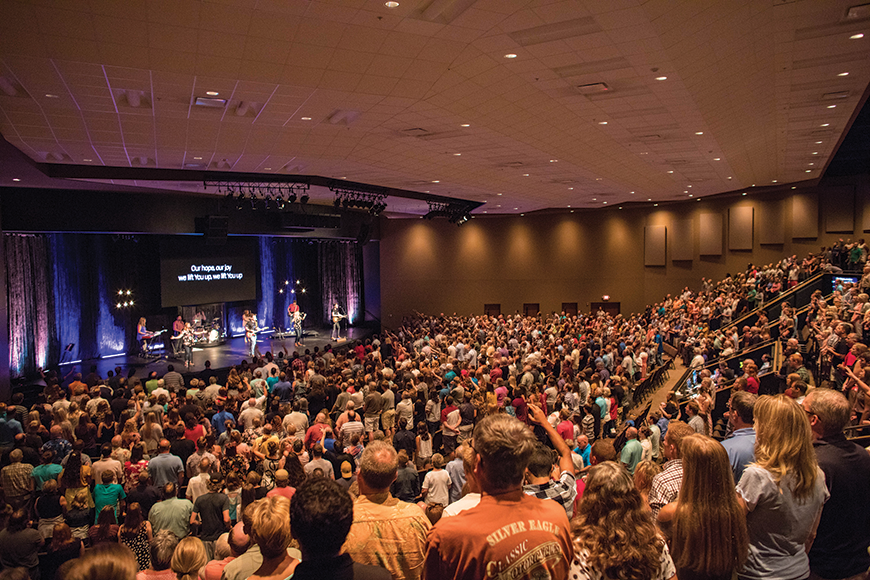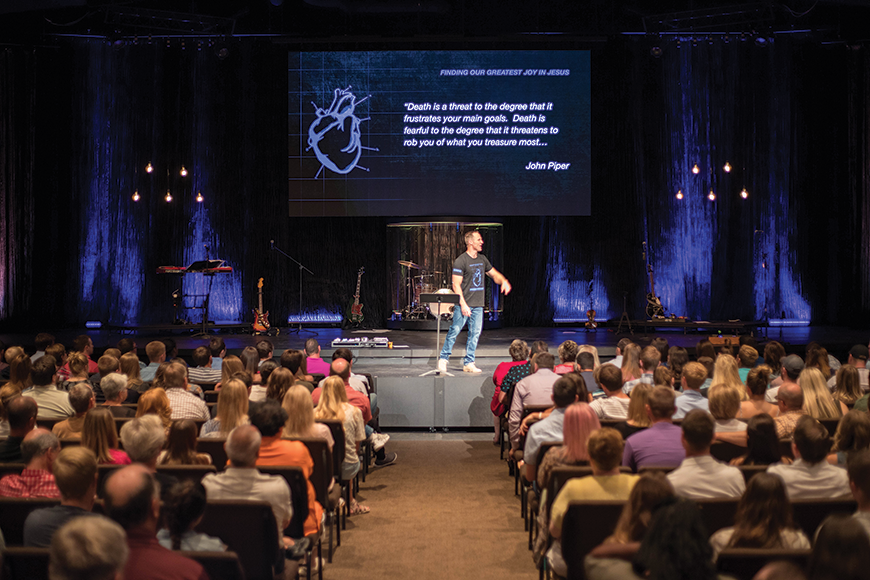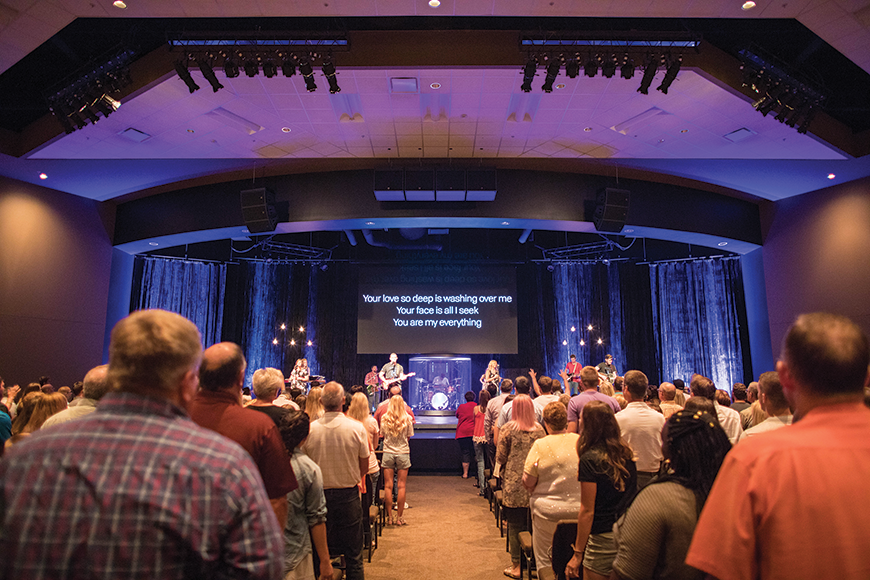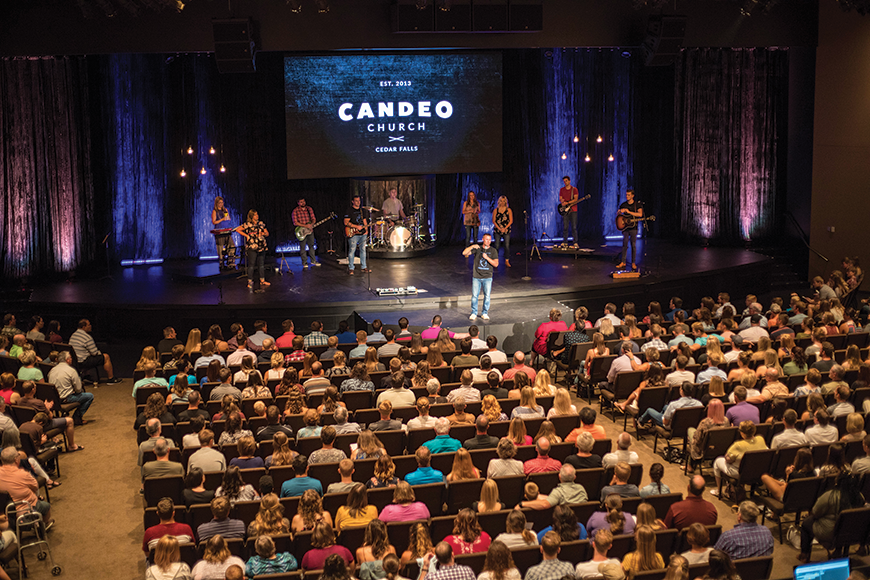Candeo Church recently faced a challenge that many growing churches find themselves confronted with: finding, and moving into, a larger venue. Candeo is part of the Salt Network of churches that developed out of Cornerstone Church in Ames IA. Thanks to the Salt Network’s college-focused approach to ministry, and Candeo’s proximity to the University of Northern Iowa, Candeo’s weekly attendance numbers quickly outgrew capacity at its previous location, which was a warehouse-like facility in Waterloo IA.
“We grew fairly rapidly in that location,” Tim Oldre, Candeo’s Technical Arts Leader and Facility Manager, recalled. “We were seeing peaks in attendance in the range of probably 800 people on a Sunday. After our first service in that facility, it was only two weeks later that we started doing two services, just because we were already bursting at the seams. So, it was clear to our elders that we needed something different.”
As part of the early planning stages of securing a new facility, Candeo’s leadership met with leaders from another local church, Heartland Vineyard Church, which had built a brand new building in Cedar Falls IA some 13 years earlier, to discuss the process of building a new space from the ground up. However, over the course of those conversations, it became clear that Heartland’s Cedar Falls facility was not the best fit for its own ministry goals, either; ideally, Heartland would have preferred a smaller venue. As a result, a new solution emerged that would solve both churches’ problems: They would swap locations, with Candeo moving into the Cedar Falls building and Heartland moving into the Waterloo venue.
Once the moves were complete, Candeo began the process of remodeling its new location to make the building its own and update the AV technology in the sanctuary. The church solicited designs from a number of integrators, but the clear winner was Tumwater WA-based CCI Solutions.
“CCI came in with their Accelerated Collaborative Design Process, where they come in, chat with you one day, work much of the night to get a budget together and then present a budget the next day,” Oldre recalled. “That process was really huge. It helped us, number one, to know what we were looking at dollar-wise and, number two, to develop a good relationship with CCI right away, because it was very immediate. Overnight, they hit the mark.”

Fortunately for CCI, Candeo’s new location was an easy one to approach. “The beauty is, Candeo bought a reasonably well-thought-out building,” Duke DeJong, CCI’s VP of Sales and Integration, explained. “The entire campus is relatively new. It’s got a very nice auditorium that’s a moderate fan shape with stadium seating in the back. I think the whole room holds maybe 1,000 people, so, for the middle of Iowa, it’s a pretty good-sized space. Most things, architecturally, were pretty well thought out. There isn’t a bad seat in the room. They all point right toward downstage center. The lighting grid, the front-of-house layout, the whole stage…it’s all set up very much like you would normally see a theater.” He added, “Really, the only challenge with the room, for the most part, was that everything was 13 years old. So, we walked into a good situation. It was a room that didn’t need a ton, and it’s a church that’s used to rocking things on a budget.”
Although the venue itself didn’t present many challenges for the integration team, the project did have to be completed on a short timeline, which complicated things somewhat. According to DeJong, “We did our design kickoff March 29 and March 30—that’s the first time we met with their team—and they were in their building by the end of July. So, this was fast.” The compressed schedule, combined with the unique venue-swap aspect of the project, was the biggest hurdle that CCI had to overcome. “I think the biggest challenge on this project was the timeline,” DeJong conceded. “They moved out of their existing building at the end of June, and they needed to be set up and in this new building by the end of July. But, of course, the current occupants of that building were moving into their old building at the same time. There was no way to do anything ahead of time. There was basically this one-month ‘OK, everybody go!’ free-for-all to try to get everybody into their new buildings.”

The CCI team, led by Project Lead and Director of Design and Engineering Todd Gathany, was initially tasked with an overhaul of the main sanctuary video system. Candeo was originally considering an ambitious (perhaps overly so) approach to video that would have required a lot of projectors. “We had this idea in our head that was going to be five projectors’ worth,” Oldre recalled. “My boss, Worship Arts Director Jake Hering, had at some point suggested an LED wall, and I kind of dismissed it, saying, ‘Oh, that’s going to be too expensive.’ But then, when CCI was doing their thing, during the design process, they said, ‘Well, what about this concept—one really good screen.’ And we looked at each other and went ‘…huh.’”
Candeo felt the one-screen idea was more suited to its style of worship, which prioritizes avoiding anything that could be perceived as “over the top.” And, after initially being skeptical of the expenses associated with LED walls, church leadership was pleasantly surprised by the actual cost. According to Oldre, “Duke said to us in the design process, ‘You know, to do something quality with projectors, you’re going to be at about two-thirds the cost of the LED screen. And you’re going to have the maintenance costs of a bulb every year. And the projection screens don’t turn black when they’re not being used.’ So, when they brought the prices to us the next day, they were obviously very expensive, but none of the prices blew us out of the water or had us saying, ‘That’s crazy.’ So, we were really pleased.”
CCI decided on an LED wall composed of 66 Absen D3 panels. The wall measures 18’x9.84′. “The Absen D3 is a panel that has done very well for us,” Gathany said. “It’s a 3.9-millimeter-pixel-pitch, half-meter-by-half-meter tile. On price per performance, it was built for the church.” He added, “Most churches, when they fly a wall, they’re going to move it once or twice a year, so they don’t need the touring-grade, heavy-duty walls with all the road cases that Absen has been known for. So, we’ve been working with them to come up with a good flyable solution that was more in a budget price range, with lighter hardware and really good price per performance. The D3 really fits the bill. It’s something that we use frequently, and it’s just a really killer-looking wall.”

The LED wall was actually the last thing installed in the sanctuary; thanks to the long freight transit time from China and the small project window, the videowall went up at pretty much the last second. “They were installing it on a Friday, and we had our service on Sunday, so it was very last minute,” Oldre confirmed.
Although the LED wall made it into the space just barely under the wire, CCI impressed Oldre by making sure the company’s team had everything rigged and ready to go, in advance, according to Candeo’s specifications, so that the LED tiles just had to be put into place. Oldre said, “This was one of the cooler things that CCI did: When we were trying to come up with the trim height for the LED wall, we wanted it to be as low as possible, while still being able to roll our drum enclosure underneath it. They had rigged for the right height in advance, and I was watching the guy build the wall, looking at our drum equipment and thinking, ‘There’s no way it’s going to make it.’ Then, when he was done building the wall, the drum case fit underneath, and it had about an inch of clearance. So, I was very impressed with the fact that they nailed that—every piece of rigging and every panel—without actually having the wall there. I was blown away!”
Gathany elaborated on the infrastructure of the video system that feeds the LED wall, saying, “It’s driven by a NovaStar 660 as the sending box, which is fed by a Roland XS82 matrix switcher/scaler.” Gathany continued, “It’s an eight-in, two-out box, so they can route different computers and graphical options in and have a seamless switch to the LED wall, and then that second output they can use for their confidence monitors or the lobby feed.” Two W-Box 65-inch LED HDTVs hung above the entryways on both sides of the sanctuary are used as confidence monitors. Mac computers serve as inputs for the video system.
Content shown on the LED wall includes greetings displayed at the beginning of the service, song lyrics, Bible verses and themed graphics created by Candeo’s Graphic Artist Kari Kluesner. Sermons, but not musical performances, are recorded and later uploaded to the church’s website; however, there is no live IMAG during services. “When we came into the auditorium, we asked, ‘Is this an IMAG auditorium?’” Oldre said. “And everyone we talked to about it seemed to agree that the room was just on the edge. So, we decided to go without it at this point, just because, obviously, that’s going to be a lot of cost, too. And the other thing is, once you introduce IMAG, people tend to just watch the screen anyway.” He added, “Probably one of the biggest things for us is having a connection between the congregation and the band leading the worship. We don’t want it to be a concert. We want the band to be up there connecting with the congregation.”
Candeo originally wanted to keep as much of the new building’s preexisting audio system intact as possible, at least for the short term. However, CCI managed to convince church leadership to upgrade immediately, citing the age of the system and some uneven coverage throughout the seating area. “One of the things was that, with how many speakers there were in the old system, there were going to be hot spots and dead spots and all sorts of things like that,” Oldre explained. “And Duke told us, ‘I’m really concerned, after learning about your church, that you’re not going to be pleased with what’s in there. Let us at least pitch you some dollar figures.’ When they were able to come the next day and show us not only the dollar figures, but also the mapped-out auditorium and the coverage map of the speakers…seeing the coverage map with even coverage sold us on upgrading.”
“Really, walking into the new building, we felt that the PA was built for a much more traditional style, and it wasn’t going to have the horsepower they needed,” DeJong said. “So, the PA was a definite change-out.”
As a replacement, CCI specified L-Acoustics ARCS FOCUS line arrays, flown stage left and right. Each array consists of two ARCS FOCUS two-way, constant-curvature modules, plus an additional ARCS WIDE module as the bottom element of the array. “We’ve been a big fan of the ARCS speakers for a number of years now,” DeJong said. “We keep using them in these 400-to-1,000-seat auditoriums, and they just keep killing it. So we’re very familiar with the speaker. We built the model in L-Acoustics SoundVision and got a pretty good idea of where they were going to fit, so we were able to prove pretty quickly that a left/right pair would take care of the bulk of the room. The one part of the room that they did not cover well was the front row or two.” To compensate for the gap in front-row coverage, CCI installed four L-Acoustics 5XT speakers along the front of the stage as fills.
Four L-Acoustics SB18I subwoofers are suspended above the stage between the line arrays. “With that big center LED wall, what we didn’t want to do was have a lot hanging down vertically,” Gathany explained. “We also didn’t want to split the stack of four subs two to each side.” With these concerns in mind, CCI turned to a flown subwoofer array, a solution the company has been deploying in more of its installations as of late. “We’ve done some rooms where we’ve done center-flown arrays, and rooms where we’ve split them up and put them on each side,” Gathany continued. “As you would expect, when you do them on each side, you get power alleys down the middle, and it’s just not as seamless as we would like. If we fly them in the center, they radiate consistently well, and, as long as their distances aren’t too great, the coverage from center to far corner is within +3dB, which is our design criteria. So, we’ve been doing a lot more of the horizontal sub stack in the center. Plus, if you need a cardioid arrangement, flip one of them backward and you’ve got it. It’s been a good arrangement for us, and we’re doing it more and more.”
Three L-Acoustics LA4X amplifiers drive the speakers and subs. These amplifiers handle the bulk of signal processing, but an additional Symetrix Radius DSP was also included. “When we do an L-Acoustics system, we can do a lot of the processing in the amplifiers, but we still tend to include a DSP box,” Gathany said. “Sometimes, it’s for coloring the system, but, sometimes, it’s for routing as much as anything else. So, feeds to lobbies, feeds to backstage, cry rooms, green rooms, whatever.”
Candeo decided to keep its old mixing console for now. “The customer already had a Midas M32 console. We did add the DL32 stage box, so that they could get 32 channels preamped from the stage back to the box via Cat5. So, we just filled out the existing system,” Gathany said. Typically, Candeo’s praise bands don’t feature more than a dozen or so performers, so, for most services, a lot of inputs aren’t necessary. However, Candeo has already begun to experiment with more creative, expanded musical arrangements, which have been made possible by the new venue’s larger stage. Because the production team is already bumping up against the limits of its channel count, an upgrade might be in the cards sooner rather than later.
Candeo’s reaction to the completed system has been positive. “It was a very cool opening weekend,” Gathany said. “They were really excited with the engagement from the audience, both visually and audibly. The Pastor of Vision and Teaching, Paul Sabino, came up to us and said, ‘Man, I had my doubts, but that screen is awesome. There isn’t a seat in the house that that thing doesn’t grab your attention.’”
